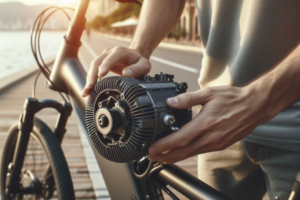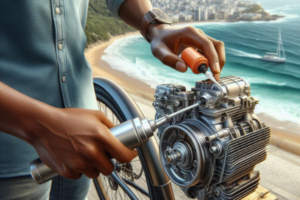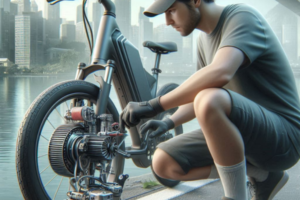🌫️ Why Humidity Is a Hidden Threat to Your E-Bike Motor
Electric bicycles are transforming urban mobility across the world, offering eco-friendly, efficient, and enjoyable transportation. But while many riders focus on battery range and tire pressure, there’s one critical component that often goes overlooked — the motor. In humid environments, this component silently endures one of the harshest tests in micro-mobility: moisture, condensation, and corrosion.
Humidity isn’t just about rainy days. It’s an atmospheric condition that seeps into everything over time — from your frame to your bearings, and especially to the electrical and mechanical components inside your motor. Moisture in the air can cause the motor casing to sweat, allow rust to form inside sealed compartments, and oxidize sensitive connections between the battery, controller, and motor. This reduces efficiency, drains your battery faster, and in worst-case scenarios, can cause total motor failure.
This is especially true in tropical, subtropical, or coastal cities, where high humidity levels are part of daily life. If you live in places like Miami, Manila, Rio de Janeiro, or Ho Chi Minh City — or even regions that experience seasonal monsoons — protecting your motor must become part of your regular riding and maintenance strategy.
🔍 Understanding How Humidity Affects E-Bike Motors
To properly protect your motor, you first need to understand how humidity causes damage at a technical level. Here are the primary risks:
- 💧 Condensation inside the motor housing: Sudden temperature changes between indoor storage and outdoor riding cause water vapor to condense inside the motor shell.
- 🧪 Electrochemical corrosion: Moisture reacts with metal parts — especially copper windings and steel bearings — leading to performance decline.
- 🔌 Connector and wiring degradation: Even waterproof systems can suffer over time as moisture sneaks into worn seals or poorly protected connectors.
- 🌬️ Reduced cooling performance: High humidity reduces the rate at which heat escapes the motor, increasing internal stress and component wear.
These risks may be invisible to the eye, but they manifest in subtle performance issues: jerky acceleration, lower torque, noisier operation, or faster-than-expected battery drain. Often, these symptoms are mistakenly blamed on firmware bugs or controller malfunctions, when the real culprit is environmental degradation.
💡 Reflection for Conscious Riders
“Humidity is not loud — it whispers into your motor day by day. But preparation speaks louder.”
In the upcoming sections, we’ll explore specific, practical strategies to defend your e-bike motor from humidity’s invisible reach. From smart technology and protective coatings to routine care and simple upgrades, you’ll discover how to ride strong and smooth no matter how damp the air around you becomes.
⚙️ Smart Technologies That Shield Your Motor from Humidity
Fortunately, as awareness of humidity’s impact has grown, so has the availability of technology designed to fight it. Whether you’re purchasing a new e-bike or looking to upgrade your current one, these features and accessories can drastically extend the life of your motor in moist environments.
🌡️ 1. Sealed Motor Housings with IP Ratings
The most direct line of defense is your motor’s shell. Look for motors rated at least IP65 — this means they are dust-tight and protected against low-pressure water jets. Higher ratings like IP67 or IP68 offer protection from temporary or extended water immersion. These enclosures reduce the chance of condensation entering the motor when riding through rain or storing in a damp environment.
🔌 2. Waterproof and Marine-Grade Connectors
The motor’s connectors — the points where cables plug into the motor — are often the weakest link. Upgrading to marine-grade, gold-plated connectors with rubber gaskets reduces the risk of signal interference and energy loss. Brands like Higo or Julet offer waterproof connector systems commonly used in coastal transport equipment.
🧴 3. Anti-Corrosion Coatings and Dielectric Grease
Applying a protective layer of dielectric grease inside connectors or on terminal contacts blocks out moisture and prevents rust. You can also spray a thin coat of anti-corrosion solution like ACF-50 or Boeshield T-9 on the outer surface of the motor housing, bolts, and screws. These coatings are lightweight, invisible, and form a protective barrier against oxidation and salty air.
📱 4. Smart Motor Health Apps
High-end e-bike systems like Bosch, Shimano, or Bafang include integrated diagnostic apps that monitor motor behavior. These apps detect performance drops, overheating, or irregular battery drain — all of which can signal humidity-related degradation. Early warnings allow riders to intervene before permanent damage occurs.
🌬️ 5. Passive Ventilation and Heat Shields
In warm, humid climates, motors may overheat more quickly if ventilation is poor. Certain e-bike brands now offer breathable motor covers or frame-integrated vents that regulate internal airflow. Some riders also use aftermarket reflective wraps to prevent external heat from intensifying internal humidity buildup.
📊 Visual Comparison: Standard vs. Humidity-Ready Motor Features
| Feature | Standard E-Bike Motor | Humidity-Resistant Setup |
|---|---|---|
| Motor Casing | Plastic shell, unsealed | Aluminum shell, IP67 rated |
| Connectors | Standard plug | Waterproof, gold-plated with gaskets |
| Surface Protection | None | Dielectric grease + corrosion spray |
| Monitoring | Basic LED display | Diagnostic app with real-time alerts |
💬 Wisdom from the Field
“When humidity rises, the smartest motor isn’t the fastest — it’s the most protected.”
Investing in smart motor protection isn’t about luxury — it’s about longevity. These upgrades don’t just protect your ride; they preserve your freedom to move through the world, no matter the weather.
🌍 Real Story: How Smart Habits Saved Emma’s Motor in Singapore
Emma, a freelance designer living in Singapore, uses her electric bicycle to travel across the city’s vibrant neighborhoods. She chose an e-bike over a car for sustainability, but within six months, her motor began making odd clicking noises and would sometimes cut out on wet days. Confused and worried, Emma visited a local service center, where the mechanic discovered light rust on the interior of her rear hub motor.
Although her e-bike had never been submerged in water, the high humidity and frequent short rides had allowed condensation to build up inside the motor housing. The lack of ventilation and a few splashes during monsoon season had sealed its fate — unless something changed fast.
With guidance from the technician and her own research, Emma implemented a care routine. She applied dielectric grease to her connectors, used ACF-50 spray every three weeks, and invested in a breathable cover for storage. She also started using her manufacturer’s mobile app to monitor torque output and battery efficiency. Within a month, the motor was running smoother, and a year later, it was still going strong — despite Singapore’s relentless humidity.
🛠️ Practical Motor Protection Tips for Everyday Riders
No matter where you ride, good motor care habits can make a huge difference. These aren’t just about repairs — they’re about daily awareness and long-term resilience. Here are some of the most effective tips you can apply starting today:
- ✅ Wipe down your motor casing after every ride — especially if you ride near rivers, the ocean, or during rainy seasons. Salt and dust particles can collect even without visible dirt.
- ✅ Apply protective spray monthly to bolts, seams, and exposed areas. Use products made for electronics or bikes — never generic household oils.
- ✅ Check power cables weekly for signs of fraying, moisture, or dirt at connection points. Replace any rubber seals that appear cracked or loose.
- ✅ Run firmware updates using your e-bike’s mobile app or diagnostic software. This helps ensure your motor operates within safe electrical parameters, especially when conditions are inconsistent.
- ✅ Use breathable storage solutions — avoid trapping your e-bike in a sealed plastic cover in humid environments. Instead, choose a ventilated space with consistent airflow.
These steps may seem simple, but combined, they form a shield around your motor. Just like Emma’s story shows, consistency is more valuable than expensive repairs — and will keep your motor healthy, quiet, and powerful for the long road ahead.
💡 Reflection from the Tropics
“A strong motor isn’t just made in the factory — it’s built ride after ride, by every choice you make to protect it.”
Humidity may be invisible, but its effects are real. With small changes and big awareness, you can ride confidently no matter how thick the air feels — just like Emma does, with the wind in her hair and a motor that knows it’s cared for.
🚫 Common Mistakes That Harm Your E-Bike Motor in Humid Conditions
Humidity doesn’t destroy your electric bicycle motor in one day — it wears it down little by little through habits that often seem harmless. Many riders unknowingly create conditions that allow moisture to build up or corrosion to accelerate. Avoiding these common mistakes can make the difference between a smooth ride and a silent breakdown.
- ❌ Storing your e-bike under plastic sheets: Plastic covers may protect from rain, but they trap humidity like a greenhouse. Over time, condensation builds up inside the motor housing and along the connectors.
- ❌ Ignoring small power fluctuations or strange noises: Minor surges or buzzing sounds may seem insignificant, but they often signal corrosion in wires or weakened motor coils due to moisture.
- ❌ Using household oils on your bike motor or bolts: Many all-purpose lubricants are not designed for electronics or coastal air. They attract dirt and break down quickly, offering no real protection.
- ❌ Cleaning with direct hose pressure: Even sealed motors can be compromised when sprayed directly. Water under pressure can sneak past gaskets and seals, especially in older units.
- ❌ Skipping updates or diagnostics: Modern motors often rely on smart systems. If your firmware is outdated, it may not manage thermal or moisture risks correctly.
Understanding these mistakes helps you build better habits. Your motor doesn’t ask for much — just a little care, consistently given.
📋 Weekly Checklist: Motor Protection in Humid Environments
To make motor care part of your lifestyle, keep this checklist visible near your storage area. Most of these steps take less than 5 minutes but can extend your motor’s life by years.
- ✅ Wipe the motor casing with a microfiber cloth after each ride.
- ✅ Check for rust, salt buildup, or discoloration near bolts and seams.
- ✅ Inspect all motor-related connectors and cables weekly for wear or moisture.
- ✅ Reapply dielectric grease to connectors every 4–6 weeks.
- ✅ Spray corrosion inhibitor on exposed metal parts once per month.
- ✅ Ensure ventilation around storage area — never seal the bike in plastic.
- ✅ Run diagnostics or firmware updates at least once every 2 months.
You can print this list or add it as a digital reminder. Turning these steps into routine actions helps you stay ahead of invisible threats — especially in unpredictable coastal and tropical climates.
💬 A Truth to Ride With
“You don’t need to be a mechanic to protect your motor — you just need to be present, attentive, and consistent.”
This checklist isn’t about fear. It’s about empowerment. When you know what to do and when to do it, you gain control over how long your motor lasts — no matter how humid the air gets.
❓ Frequently Asked Questions (FAQs)
Is it necessary to protect the motor even if I don’t ride in the rain?
Yes. Humidity affects your motor even without direct water contact. Moisture in the air can enter through small gaps, especially during temperature shifts. Coastal and tropical environments often have high humidity all year long — even on dry days.
What’s the safest way to clean my motor without risking damage?
Always avoid high-pressure water. Use a damp microfiber cloth to gently clean the motor casing. For stubborn grime or salt, use a light spray of electronic-safe cleaner, followed by drying with a clean cloth. Never aim a hose directly at your motor or connectors.
Can I apply dielectric grease or anti-corrosion spray myself?
Absolutely. These products are easy to use and available at most bike or hardware stores. Apply a small amount of dielectric grease to connector pins and corrosion inhibitor spray to bolts, seams, and exposed surfaces. Follow product instructions carefully and reapply every few weeks in humid areas.
Are hub motors or mid-drive motors better for humid environments?
Both can perform well if properly protected. Hub motors are often more sealed, while mid-drive systems may be more exposed but easier to access and maintain. The key is not the motor type — it’s how well you care for it based on your environment.
What if I don’t have access to a garage or indoor storage?
If indoor storage isn’t an option, use a breathable waterproof cover, and place your e-bike in a shaded, ventilated area. Avoid sealing it in plastic. Elevate the bike slightly from the ground to avoid moisture pooling underneath, and check for condensation frequently.
💬 Final Thoughts
Your motor is the silent force behind every hill you climb and every breeze you chase. In humid environments, its protection becomes a form of respect — for your ride, your freedom, and your investment.
But motor care isn’t complicated. With small habits, smart upgrades, and consistent attention, you don’t just avoid problems — you ride smarter, farther, and with greater peace of mind. Every wipe, every spray, every check is a moment of connection with the machine that carries you.
🌟 Join the Conversation
Do you live in a humid city? What have you done to protect your electric bicycle’s motor from moisture? Have you discovered a product, a habit, or a tip that made all the difference?
Share your experience in the comments below — your advice could help someone else ride stronger in their climate, too.
Let’s build a community of riders who protect what moves us — and support one another every step of the journey.



